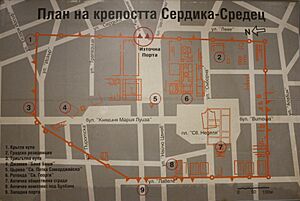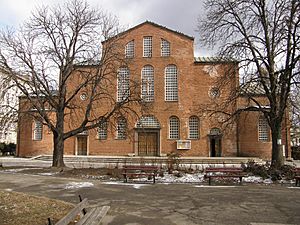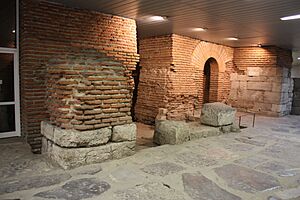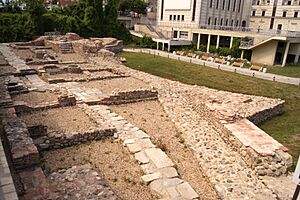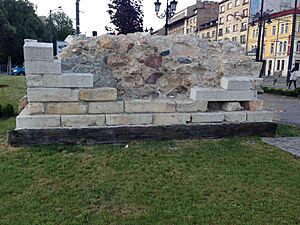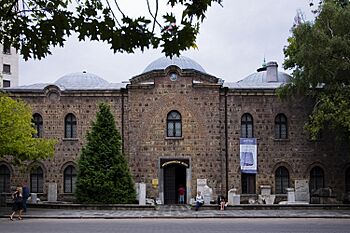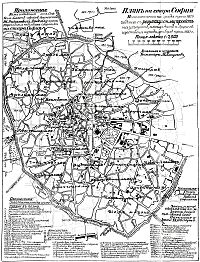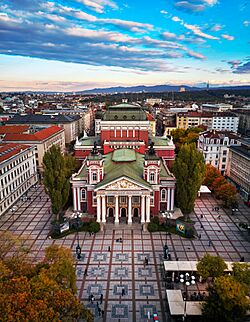History of Sofia facts for kids
The history of Sofia, the capital and largest city of Bulgaria, goes back thousands of years. From ancient times to today, Sofia has always been an important center for trade, industry, culture, and economy in its region and the Balkans.
Contents
Ancient Sofia: A City of Many Names
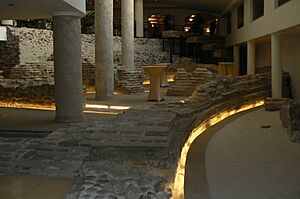
Early Settlements and Thracian Times
People first settled in the area of Sofia a very long time ago. A village from the Stone Age (Neolithic period) was found in Slatina, dating back to about 6,000 BC. Another ancient settlement was discovered near the National Art Gallery. It dates from 3,000 to 4,000 BC.
The first known tribes to live here were the Thracian Tilataei. Around 500 BC, this area became part of a Thracian kingdom called the Odrysian kingdom. In 339 BC, Philip II of Macedon attacked and destroyed the town.
Roman Rule and Serdica's Rise
The Celtic tribe called the Serdi gave the city its early name. The first mention of the city, as Astiu ton Serdon (city of the Serdi), is from an Athenian writing in the 1st century BC. Around 29 BC, the Romans conquered Sofia.
The city grew to be the most important Roman city in the area. It became a municipium, which means a self-governing town, during the rule of Emperor Trajan (98-117 AD). It was then renamed Ulpia Serdica.
In 170 AD, the city was burned by the Costoboci. It was rebuilt with its first defensive walls between 176 and 180 AD under Emperor Marcus Aurelius. The city grew even more, with public baths, government buildings, and a large theater.
When Emperor Diocletian divided the province of Dacia, Serdica became the capital of the new province, Dacia Mediterranea. Two Roman emperors, Aurelian (215–275 AD) and Galerius (260–311 AD), were born in Serdica. In 268 AD, a Gothic attack damaged parts of the city.
Christianity and Imperial Importance
Serdica continued to grow and became a major political and economic hub. It was one of the first Roman cities where Christianity became an official religion. The Edict of Toleration was issued in 311 AD in Serdica by Emperor Galerius. This important law officially ended the persecution of Christianity. It allowed Christians to practice their faith freely.
An amphitheater was built over the old theater under Diocletian and later Constantine the Great. Constantine the Great loved Serdica so much he said, "Serdica is my Rome." He even thought about making Serdica the capital of the Byzantine Empire instead of Constantinople.
In 343 AD, an important church meeting, the Council of Sardica, was held in a church. This church was located where the 6th-century Church of Saint Sofia stands today.
The city was destroyed by the Huns in 447 AD. However, it was rebuilt by Byzantine Emperor Justinian in the 6th century and renamed Triaditsa. Serdica thrived again under Justinian I. Its defensive walls were made stronger, and you can still see parts of them today. The town remained under Byzantine control until 809 AD, despite frequent attacks by the Slavs.
Uncovering Ancient Serdica: Archaeology
Many parts of the ancient city have been dug up and can be seen by the public today. These include:
- The Complex Ancient Serdica area
- The eastern gate
- The western gate
- Parts of the city walls
- Ancient public baths
- A bridge over the river (near Lion's Bridge)
- The 4th-century Church of St. George Rotunda
- The amphitheatre of Serdica
- Tombs and old churches found under the Basilica of St. Sophia
Under Constantine, the city expanded north of its walls. The Roman bridge over the river became a key part of this new area. Archaeologists also found eight large warehouses (called horrea) inside the city walls. These show that Serdica was an important supply center. It was connected to the Danube River by the Iskur River valley.
Sofia in the Middle Ages

Sofia first became part of the First Bulgarian Empire in 809 AD, during the rule of Khan Krum. After this, it was known by the Bulgarian name Sredets. It grew into an important fortress and administrative center.
After several failed attempts, the city fell back to the Byzantine Empire in 1018. In 1128, Sredets was attacked by the Magyars. But in 1191, it became part of the restored Bulgarian Empire again. This happened during the time of Tsar Ivan Asen I.
During the Second Bulgarian Empire, the ruler of Sofia held the title of Sebastokrator. This title was second only to that of the Tsar (Emperor) of Bulgaria. Some famous people who held this title were Kaloyan and Peter.
From the 12th to the 14th century, Sofia was a busy center for trade and crafts. It was renamed Sofia in 1376, after the Church of St Sophia. However, people called it both "Sofia" and "Sredets" until the 16th century. Then, the new name gradually became the only one used.
Throughout the Middle Ages, Sofia was known for its goldsmithing. This was helped by the rich mineral resources in the nearby mountains. Many gold treasures found from this period, and even from ancient times, prove this.
Sofia Under Ottoman Rule
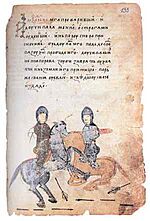
In 1385, Sofia was taken over by the Ottoman Empire during the rule of Murad I. People from Anatolia (modern-day Turkey) moved to Sofia. They joined the mostly Bulgarian-speaking population. Sofia saw the 1443 crusade led by John Hunyadi and Władysław III of Varna. This was an attempt to drive out the Ottomans, but it failed. Many Sofia residents were punished for taking part, especially those from the upper classes.
From the 14th to the 19th century, Sofia was a very important administrative center in the Ottoman Empire. It became the capital of Rumelia (Rumelia Eyalet), which was the Ottoman province in Europe (the Balkans). It was also the capital of the important Sanjak of Sofia. This area included all of Thrace (with Plovdiv and Edirne) and part of Macedonia (with Thessaloniki and Skopje).
During this time, Sofia was the biggest import-export hub in modern-day Bulgaria. It was a key point for caravan trade with the Republic of Ragusa (a city-state).
Sofia's population grew a lot under Ottoman rule. Many Ottoman buildings were built from the 15th and 16th centuries onwards. Few of these remain today, including only one working mosque, Banya Bashi. This period was very diverse, with many public investments in buildings, education, and the local economy. Records mention eight large mosques, three public libraries, many schools, 12 churches, three synagogues, and the largest covered market (bedesten) in the Balkans.
Tax records from the 16th century show a big increase in the Muslim population. At the same time, the number of Bulgarian-speaking Orthodox Christians decreased. For example, in 1524–1525, there were 915 Muslim households and 317 Christian households. By 1573, there were 1017 Muslim, 257 Christian, 127 Jewish, and 38 Roma households.
Foreign travelers reported that Sofia's population grew from 6,000 in the 1620s to 55,000 in the mid-17th century. It reached 70-80,000 in the 18th century. While these numbers might be a bit high, they show how important Sofia was during these times.
In the 16th century, Sofia was a busy trade center. Many different groups of people lived there. These included Bulgarians, Romaniote, Ashkenazi and Sephardic Jews, Armenians, Greeks, and merchants from Ragusa. By the 17th century, the city's population also included Albanians and Persians. At the end of Ottoman rule, Sofia had a population of 20,501. About 56% were Bulgarian, 30% Jewish, 7% Turkish, and 6% Roma.
In 1610, the Vatican created the Bishopric of Sofia. This was for Catholic people living under Ottoman rule in Rumelia. It existed until 1715, when most Catholics moved to other territories.
Sofia in the 19th and 20th Centuries
Sofia was taken by Russian forces in 1878 during the Russo-Turkish War, 1877-78. In 1879, it became the capital of the new, self-governing Principality of Bulgaria. This principality later became the Kingdom of Bulgaria in 1908.
Most mosques in Sofia were destroyed during that war. Seven of them were ruined in one night in December 1878. A thunderstorm helped hide the sound of explosions set by Russian military engineers. After the war, most of the Muslim population left Sofia.
In 1907, the Monument to the Tsar Liberator was opened on Tsar Osvoboditel Boulevard in Sofia. In 1925, a very serious event happened in Bulgarian history. The St Nedelya Church assault caused many deaths and injuries.
During World War II, Sofia was bombed by Allied aircraft in late 1943 and early 1944. Later, it was occupied by the Soviet Union. Bulgaria's government, which had allied with Nazi Germany, was overthrown. Sofia then became the capital of the Communist-ruled People's Republic of Bulgaria (1946–1989).
See also
- Timeline of Sofia history
- Serdi
- First Bulgarian Empire
- Second Bulgarian Empire
- Ancient Roman architecture
- Edict of Serdica
- List of oldest church buildings
- List of the oldest buildings in Sofia
- History of Bulgaria
- Architecture of the Tarnovo Artistic School
- Principality of Bulgaria
- Kingdom of Bulgaria



